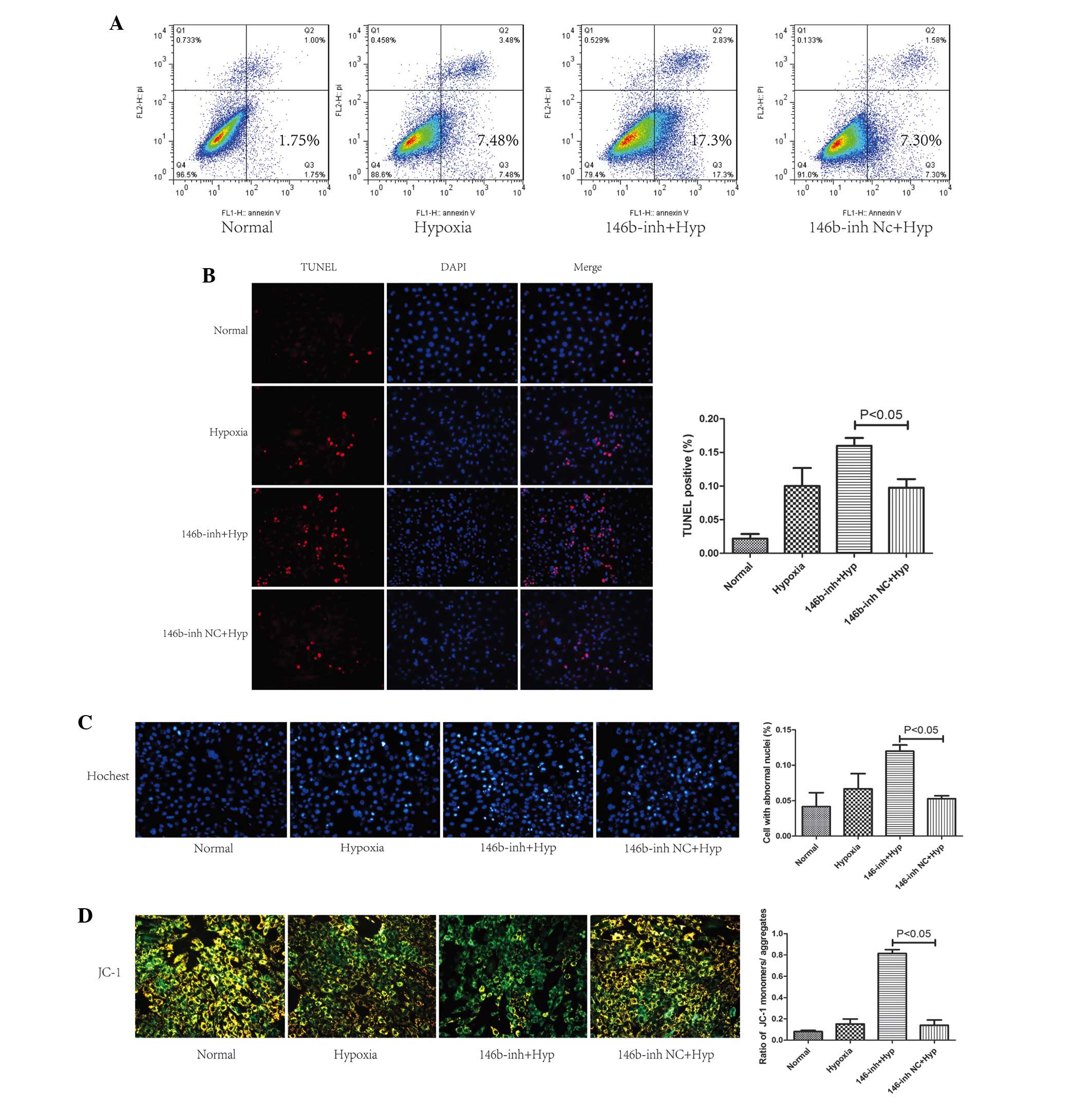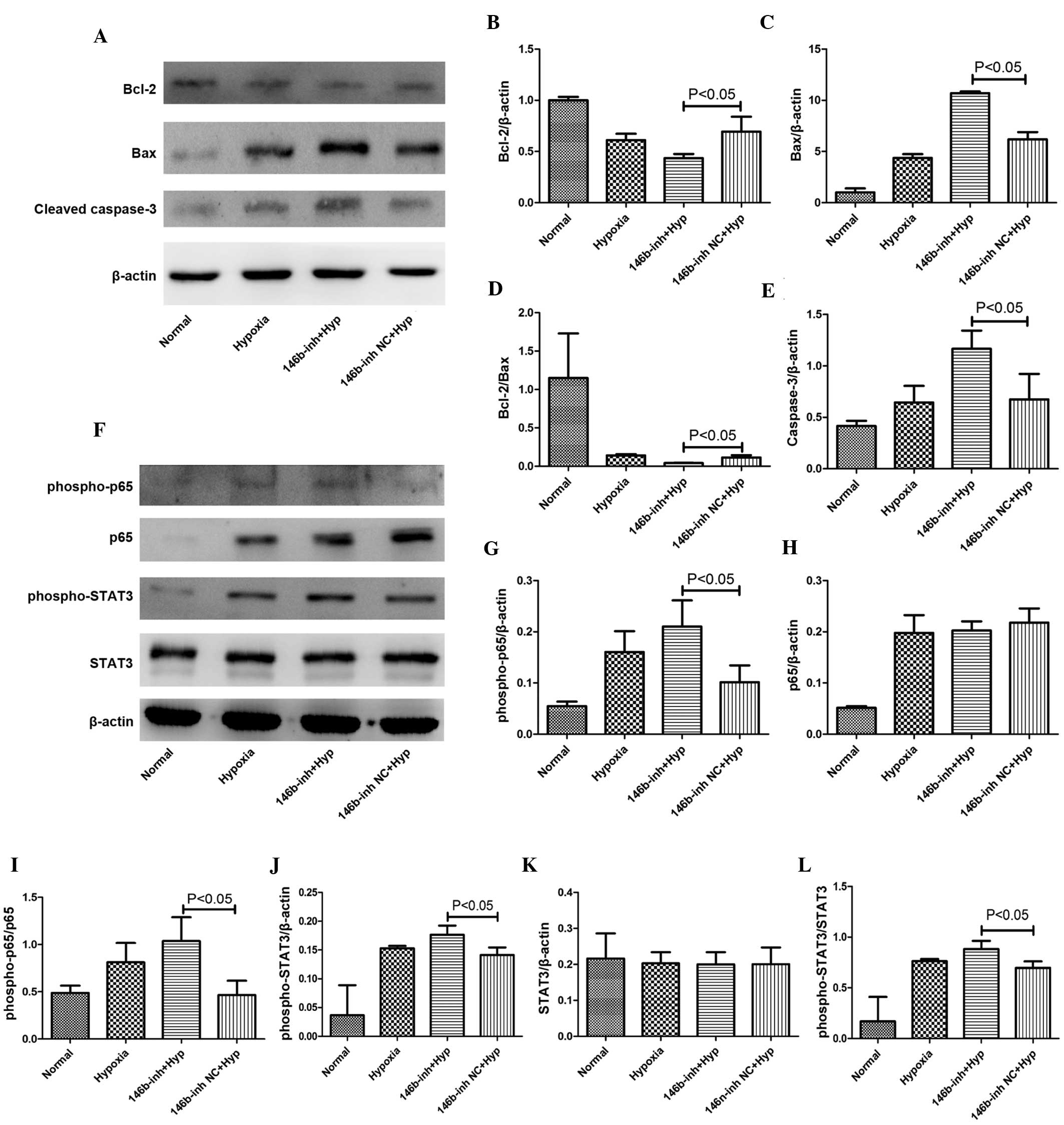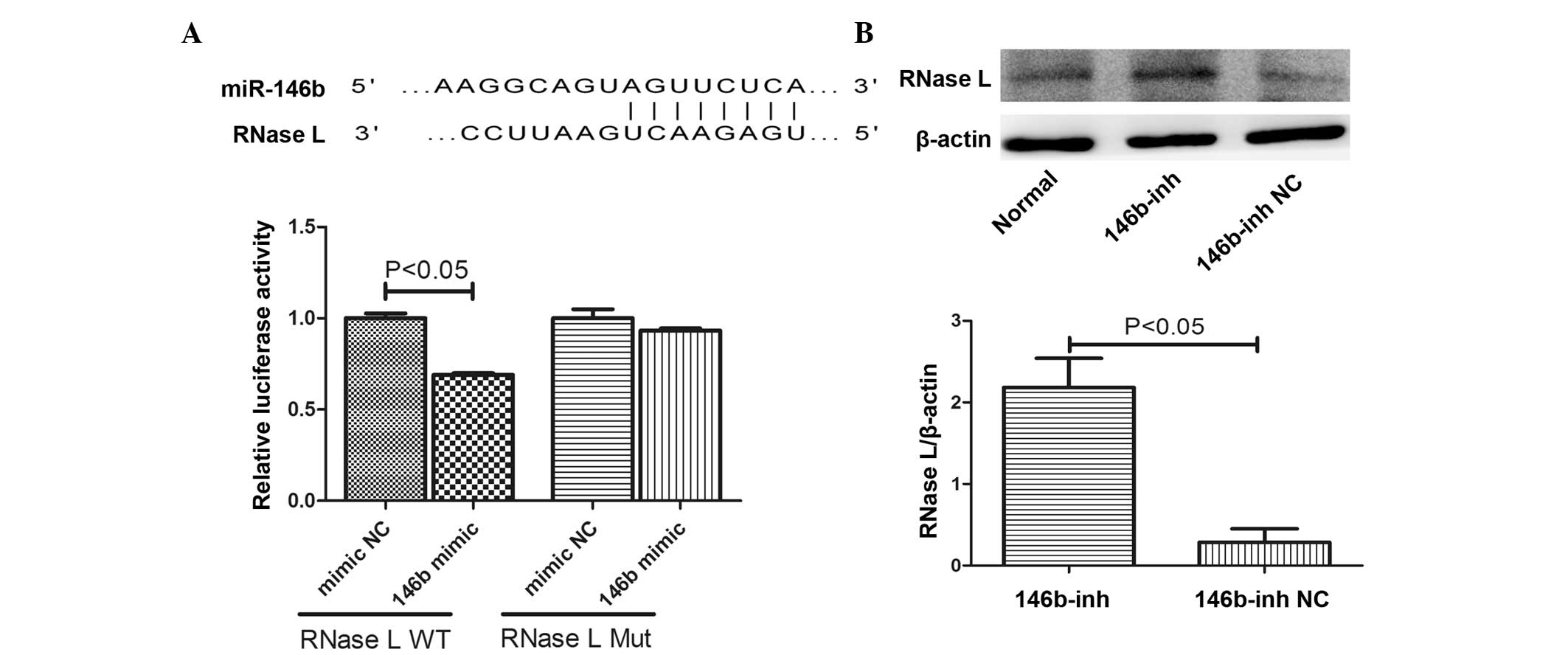|
1
|
Jian Z, Li JB, Ma RY, Chen L, Zhong QJ,
Wang XF, Wang W, Hong Y and Xiao YB: Increase of macrophage
migration inhibitory factor (MIF) expression in cardiomyocytes
during chronic hypoxia. Clin Chim Acta. 405:132–138. 2009.
View Article : Google Scholar : PubMed/NCBI
|
|
2
|
Waskova-Arnostova P, Kasparova D,
Elsnicova B, Novotny J, Neckar J, Kolar F and Zurmanova J: Chronic
hypoxia enhances expression and activity of mitochondrial creatine
kinase and hexokinase in the rat ventricular myocardium. Cell
Physiol Biochem. 33:310–320. 2014. View Article : Google Scholar : PubMed/NCBI
|
|
3
|
Hausser J and Zavolan M: Identification
and consequences of miRNA-target interactions - beyond repression
of gene expression. Nat Rev Genet. 15:599–612. 2014. View Article : Google Scholar : PubMed/NCBI
|
|
4
|
Condorelli G, Latronico MV and Cavarretta
E: microRNAs in cardiovascular diseases: Current knowledge and the
road ahead. J Am Coll Cardiol. 63:2177–2187. 2014. View Article : Google Scholar : PubMed/NCBI
|
|
5
|
He S, Liu P, Jian Z, Li J, Zhu Y, Feng Z
and Xiao Y: miR-138 protects cardiomyocytes from hypoxia-induced
apoptosis via MLK3/JNK/c-jun pathway. Biochem Biophys Res Commun.
441:763–769. 2013. View Article : Google Scholar : PubMed/NCBI
|
|
6
|
Zhang J, Chang JJ, Xu F, Ma XJ, Wu Y, Li
WC, Wang HJ, Huang GY and Ma D: MicroRNA deregulation in right
ventricular outflow tract myocardium in nonsyndromic tetralogy of
fallot. Can J Cardiol. 29:1695–1703. 2013. View Article : Google Scholar : PubMed/NCBI
|
|
7
|
Chan SY, Zhang YY, Hemann C, Mahoney CE,
Zweier JL and Loscalzo J: MicroRNA-210 controls mitochondrial
metabolism during hypoxia by repressing the iron-sulfur cluster
assembly proteins ISCU1/2. Cell Metab. 10:273–284. 2009. View Article : Google Scholar : PubMed/NCBI
|
|
8
|
Wang D, Liu YL, Lü XD, Ling F, Liu AJ, Du
J and Han L: Lung microRNA profile in chronic cyanotic piglets with
decreased pulmonary blood flow. Chin Med J (Engl). 126:2260–2264.
2013.
|
|
9
|
Taganov KD, Boldin MP, Chang KJ and
Baltimore D: NF-kappaB-dependent induction of microRNA miR-146, an
inhibitor targeted to signaling proteins of innate immune
responses. Proc Natl Acad Sci USA. 103:12481–12486. 2006.
View Article : Google Scholar : PubMed/NCBI
|
|
10
|
Curtale G, Mirolo M, Renzi TA, Rossato M,
Bazzoni F and Locati M: Negative regulation of Toll-like receptor 4
signaling by IL-10-dependent microRNA-146b. Proc Natl Acad Sci USA.
110:11499–11504. 2013. View Article : Google Scholar : PubMed/NCBI
|
|
11
|
Xiang M, Birkbak NJ, Vafaizadeh V, Walker
SR, Yeh JE, Liu S, Kroll Y, Boldin M, Taganov K, Groner B, et al:
STAT3 induction of miR-146b forms a feedback loop to inhibit the
NF-kappaB to IL-6 signaling axis and STAT3-driven cancer
phenotypes. Sci Signal. 7:ra112014. View Article : Google Scholar
|
|
12
|
Mehmet H and Edwards AD: Hypoxia,
ischaemia, and apoptosis. Arch Dis Child Fetal Neonatal Ed.
75:F73–F75. 1996. View Article : Google Scholar : PubMed/NCBI
|
|
13
|
Perry MM, Williams AE, Tsitsiou E,
Larner-Svensson HM and Lindsay MA: Divergent intracellular pathways
regulate interleukin-1beta-induced miR-146a and miR-146b expression
and chemokine release in human alveolar epithelial cells. FEBS
Lett. 583:3349–3355. 2009. View Article : Google Scholar : PubMed/NCBI
|
|
14
|
Hamid T, Gu Y, Ortines RV, Bhattacharya C,
Wang G, Xuan YT and Prabhu SD: Divergent tumor necrosis factor
receptor-related remodeling responses in heart failure: Role of
nuclear factor-kappaB and inflammatory activation. Circulation.
119:1386–1397. 2009. View Article : Google Scholar : PubMed/NCBI
|
|
15
|
Cheng HS, Sivachandran N, Lau A, Boudreau
E, Zhao JL, Baltimore D, Delgado-Olguin P, Cybulsky MI and Fish JE:
MicroRNA-146 represses endothelial activation by inhibiting
pro-inflammatory pathways. EMBO Mol Med. 5:949–966. 2013.
View Article : Google Scholar : PubMed/NCBI
|
|
16
|
Wang H, Zuo X, Wang Q, Boudreau E, Zhao
JL, Baltimore D, Delgado-Olguin P, Cybulsky MI and Fish JE:
Nicorandil inhibits hypoxia-induced apoptosis in human pulmonary
artery endothelial cells through activation of mitoKATP and
regulation of eNOS and the NF-kappaB pathway. Int J Mol Med.
32:187–194. 2013.PubMed/NCBI
|
|
17
|
Hurst DR, Edmonds MD, Scott GK, Benz CC,
Vaidya KS and Welch DR: Breast cancer metastasis suppressor 1
up-regulates miR-146, which suppresses breast cancer metastasis.
Cancer Res. 69:1279–1283. 2009. View Article : Google Scholar : PubMed/NCBI
|
|
18
|
Wang X, Ha T, Liu L, Zou J, Zhang X,
Kalbfleisch J, Gao X, Williams D and Li C: Increased expression of
microRNA-146a decreases myocardial ischaemia/reperfusion injury.
Cardiovasc Res. 97:432–442. 2013. View Article : Google Scholar :
|
|
19
|
Halkein J, Tabruyn SP, Ricke-Hoch M,
Haghikia A, Nguyen NQ, Scherr M, Castermans K, Malvaux L, Lambert
V, Thiry M, et al: MicroRNA-146a is a therapeutic target and
biomarker for peripartum cardiomyopathy. J Clin Invest.
123:2143–2154. 2013. View
Article : Google Scholar : PubMed/NCBI
|
|
20
|
Walker SR, Xiang M and Frank DA: STAT3
Activity and Function in Cancer: Modulation by STAT5 and miR-146b.
Cancers (Basel). 6:958–968. 2014. View Article : Google Scholar
|
|
21
|
Gu Q, Kong Y, Yu ZB, Bai L and Xiao YB:
Hypoxia-induced SOCS3 is limiting STAT3 phosphorylation and NF-κB
activation in congenital heart disease. Biochimie. 93:909–920.
2011. View Article : Google Scholar : PubMed/NCBI
|
|
22
|
Hilfiker-Kleiner D, Hilfiker A, Fuchs M,
Kaminski K, Schaefer A, Schieffer B, Hillmer A, Schmiedl A, Ding Z,
Podewski E, et al: Signal transducer and activator of transcription
3 is required for myocardial capillary growth, control of
interstitial matrix deposition, and heart protection from ischemic
injury. Circ Res. 95:187–195. 2004. View Article : Google Scholar : PubMed/NCBI
|
|
23
|
Domingo-Gil E and Esteban M: Role of
mitochondria in apoptosis induced by the 2-5A system and mechanisms
involved. Apoptosis. 11:725–738. 2006. View Article : Google Scholar : PubMed/NCBI
|
|
24
|
Malathi K, Paranjape JM, Ganapathi R and
Silverman RH: HPC1/RNASEL mediates apoptosis of prostate cancer
cells treated with 2′,5′-oligoadenylates, topoisomerase I
inhibitors, and tumor necrosis factor-related apoptosis-inducing
ligand. Cancer Res. 64:9144–9151. 2004. View Article : Google Scholar : PubMed/NCBI
|
|
25
|
Chakrabarti A, Jha BK and Silverman RH:
New insights into the role of RNase L in innate immunity. J
Interferon Cytokine Res. 31:49–57. 211PubMed/NCBI
|
|
26
|
Siddiqui WA, Ahad A and Ahsan H: The
mystery of BCL2 family: Bcl-2 proteins and apoptosis: an update.
Arch Toxicol. 89:289–317. 2015. View Article : Google Scholar : PubMed/NCBI
|
|
27
|
Korsmeyer SJ, Shutter JR, Veis DJ, Merry
DE and Oltvai ZN: Bcl-2/Bax: A rheostat that regulates an
anti-oxidant pathway and cell death. Semin Cancer Biol. 4:327–332.
1993.PubMed/NCBI
|
|
28
|
Shalini S, Dorstyn L, Dawar S and Kumar S:
Old, new and emerging functions of caspases. Cell Death Differ.
22:526–539. 2015. View Article : Google Scholar
|
|
29
|
Li G, Xiang Y, Sabapathy K and Silverman
RH: An apoptotic signaling pathway in the interferon antiviral
response mediated by RNase L and c-Jun NH2-terminal kinase. J Biol
Chem. 279:1123–1131. 2004. View Article : Google Scholar
|













